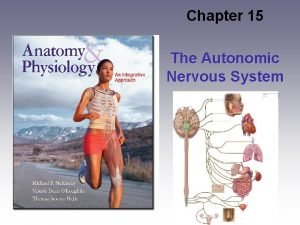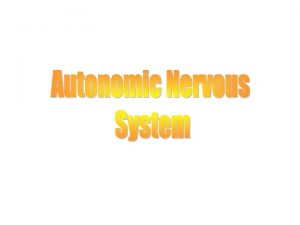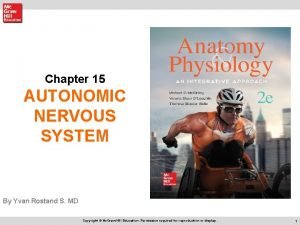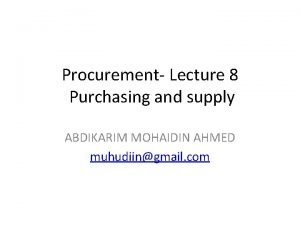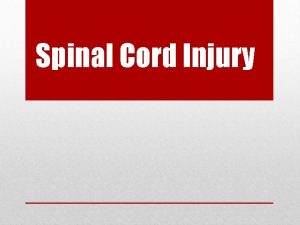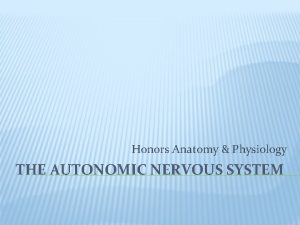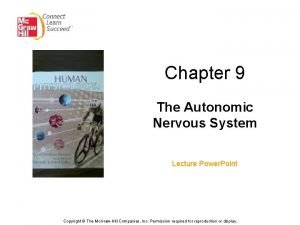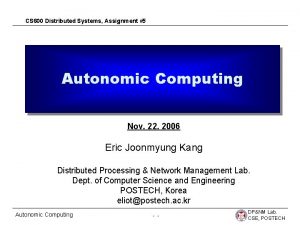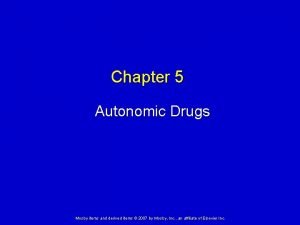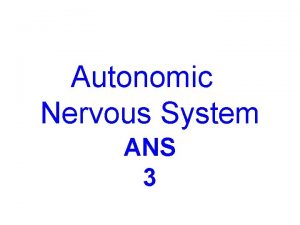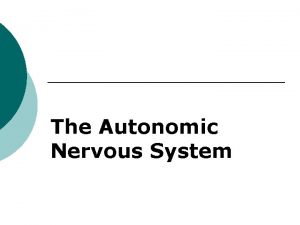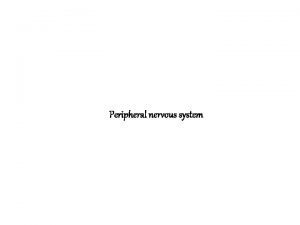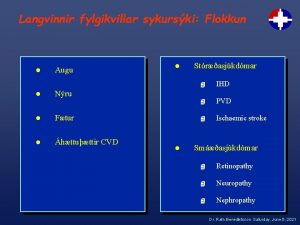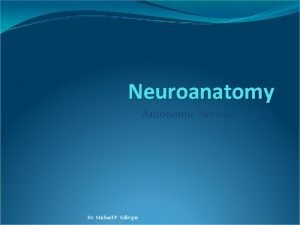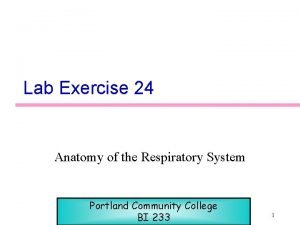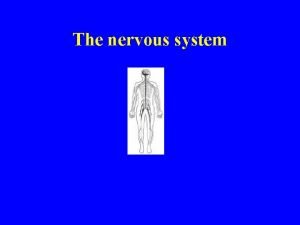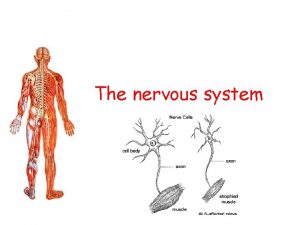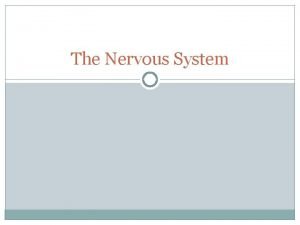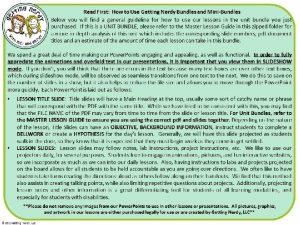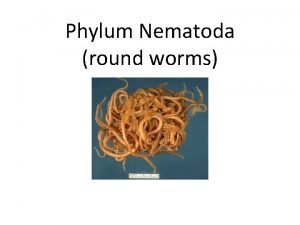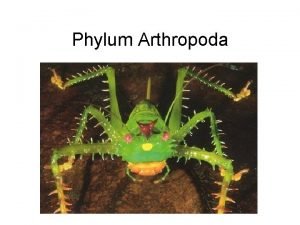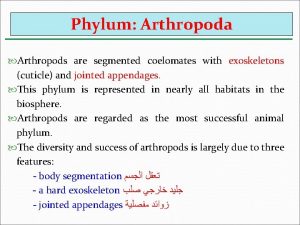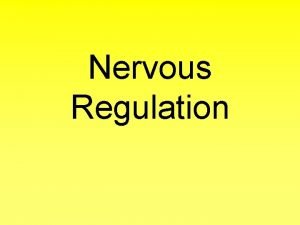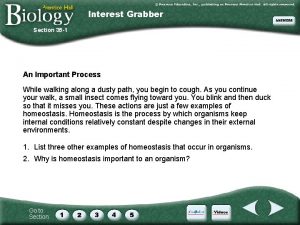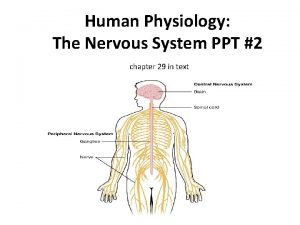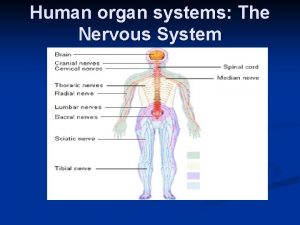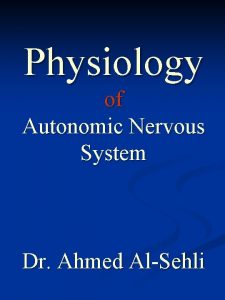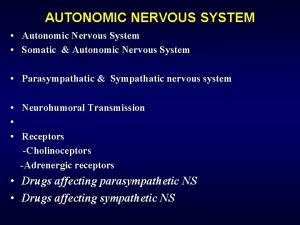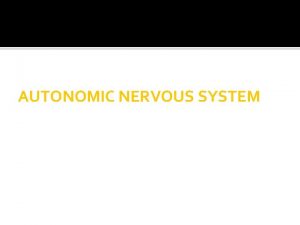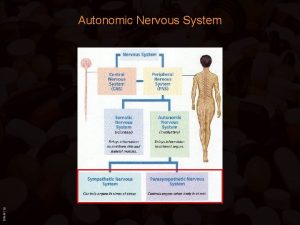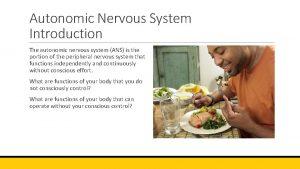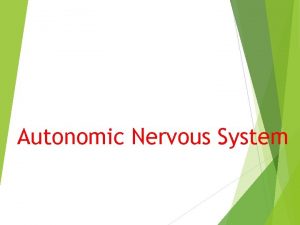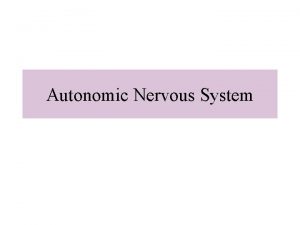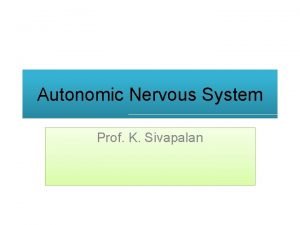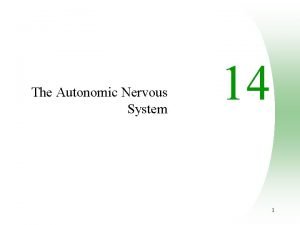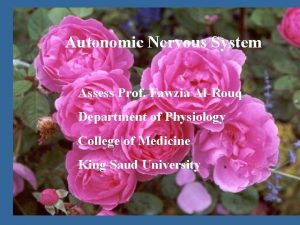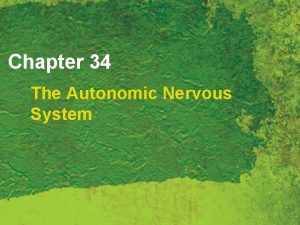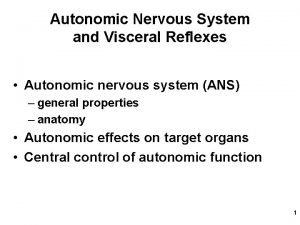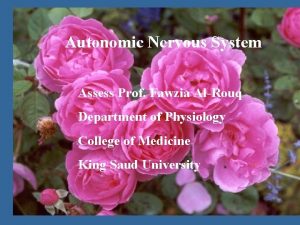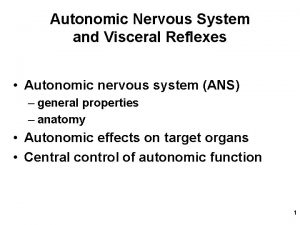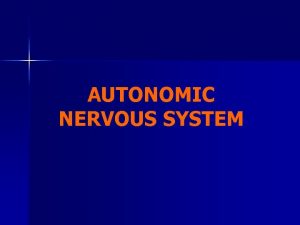Physiology of Autonomic Nervous System Dr Ahmed AlSehli

















































![RECEPTOR STIMULANTS α Receptors stimulated by : nor - adrenaline ]adrenaline} isoproterenol β Receptors RECEPTOR STIMULANTS α Receptors stimulated by : nor - adrenaline ]adrenaline} isoproterenol β Receptors](https://slidetodoc.com/presentation_image_h/ab65d0e0d7f1c33a673a5b9831a4bc61/image-50.jpg)










- Slides: 60

Physiology of Autonomic Nervous System Dr. Ahmed Al-Sehli

AUTONOMIC NRVOUS SYSTEM Definition : It is the system for involuntary subconscious functions , it controls the internal environment to maintain homeostasis. DIVISION OF NERVOUS SYSTEM : 1 - Central nervous system : a) Brain b) Spinal cord 2 - Peripheral nervous system : a) Cranial nerves Autonomic (involuntary) Somatic (voluntary) b) Spinal nerves Autonomic Somatic

Somatic N. S (voluntary) Autonomic N. S (involuntary) 1) Innervate skeletal muscles 1) Supply smooth muscles, Cardiac and Glands 2) One neurone between C. N. S and effector organ 2) Has 2 neurons connected by synapse between C. N. S & organ 3) Efferent arises from ventral horn cell. 3) Efferent preganglionic arises from lateral horn cells. 4) Chemical transmitter Acetyl choline 4) Either acetyl cholin or norepinephrine.

123 - A. N. S differs from Somatic N. S in : -In A. N. S there is : Autonomic ganglia Connector neurone is outside CNS It regulates smooth muscles Q: Discuss and differentiate the two divisions of A. N. S ?

A. N. S Sympathetic Parasympathetic 1 - ORIGIN: Thoraco-Lumber (Tl - T 12 , LI, 2, 3) Cranio - sacral 3, 7, 9, 10 S 2 , 3 , 4 1 - ORIGIN: Thoraco-Lumber Cranio - sacral (Tl - T 12 , LI, 2, 3) 3, 7, 9, 10, s 2, 3, 4, 2 -FUNCTION: Stress muscular exercise - Digestion and sleep, fear fight flight - Catabolic (energy lost from the body) 4 - DISTRIBUTION: widspread 5 - DISCHARGE : as one unit (most actions) at the same time ( Empting micturation defication - Anabolic (energy preserved) Localised To each system separetly

RELATIONSHIP BETWEEN SYMP ATHETC AND PARASYMPATHETIC 1 - RECIPROCAL : once sympathetic is stimulated, parasympaethetic is inhibited and vise - versa 2 - COMPLEMENTAL : e. g micturation and defication reflex. sympathetic for FILLING and parasympathetic for EVACUATION N. B both sympathetic and parasympathetic together help acurate control over an organ's activity.

AUTONOMIC GANGLIA DEFINITION : It is the site of physiological contact between pre and post ganglionic fibers. TYPES: a) lateral (sympathetic) b) collateral (mixed) or pure sympathetic c) terminal ( parasympathetic ) Lateral ( paravertebral) 23 ganglia: 3 = cervical sympathetic chain 12 = thoracic 4 = lumber 4 = sacral

Collateral: Around large. B. V as: - Caeliac ganglion - Superior mesentric ganglion - Inferior mesentric ganglion Terminal (in the wall of organ, no postganglionic as vagus or may be present very short post-ganglionic fiber

Pathway of pre-ganglionic sympathetic fibers: 1 - May synapse in first sympathetic chain ganglion, it enters. 2 - Synapsing in other sympathetic chain ganglia up or down. 3 - Synapse in collateral ganglia. 4 - Synapse in substance of adrenal medulla itself.

Function : 1) Distributing center: Sympathetic Parasympathetic 1 : 32 1: 9 or 1: 2 ? ? 2) Relay station between pre and post ganglionic fiber Localization : To diagnose site of relay, by Nicotine test: (Langlay's test) painting the ganglia with large doses of nicotine to block the site of relay, after that if it gives no post ganglionic response = relay Cervical Division of sympathetic

DESTRIBUTION OF SYMPATHETIC NERVOUS SYSTEM 1) CERVICAL DIVISION: Origin : It arises from lateral horn cell of Ti and T 2 and end in superior cervical ganglion I) EYE : a) dilatorpupilllary muscels = pupillary dilatation = Mydriasis b) Tarsal m. =elevation of eye lid = widening of eye superior inferior c) Muller's m. = Exophthalamos = Protrusion of eye ball in animals d) Blood vessels of eye = V. C e) relaxation of the ciliary muscle for vision

II) SALIVARY GLANDS : a) Secretion of small amount of saliva, rich in organic matters (enzymes) i. e viscus saliva. b) Squeezing around acinin of salivary glands push saliva outside III) SKIN : a) Erector pilae m = erection of hairs b) Vaso-conistriction of blood vessels = pallor c) Sweat : Secretion = mental sweat. IV) Cerebral blood vessels = vaso-conistriction

HORNER'S SYNDROME It Is Cerviacl Sympathectomy : characterized by : 1 -PTOSIS : drop of upper eyelid. 2 - MIOSIS : pupillary constriction. 3 - ANHYDROSIS : dryness of skin 4 -Emrophthalamos 5 - Flushing of the face ALL THESE EFFECTS ARE AT SAME SIDE OF LESHON

2) CARDIQ-PULMONARY DIVISION : Segments and end in 3 rd cervical and upper 4 thoracic ganglia I) HEART : increase all cardiac prosperities as: - positive inotropic effects = ↑ contractility - positive chronotropic effect = ↑ Heart rate. - = ↑ Conductivity - = ↑ Excitability II) CORONARY BLOOD VESSELS vasodilatation III) LUNG : a) bronco-dilatation. b) inhibits bronchial glands secretion of mucous IV) PULMONARY BLOOD VESSELS: vasoconstriction.

3 - SPLANCHIC DIVISION: To Abdomen and pelvis


A) Greater Splanchic Nerve : it supplies the abdomen e. g : (From T 5–T 9, relay in caeliac ganglion) a) wall of G. I. T → relaxation of its walls = retention ↓ motility. b) sphincters → its contraction e. g pyloric sphincter of stomach c) liver → glycogenolysis = glycogen converted to glucose. d) adrenal medulla → release of epinephrin and nor epinephrine. e) spleen → contraction & release of RBCs in case of heamorrhage f) adipose tissues → lipolysis. g) inhibite the intestinal juice secretion h) relaxation of gall bladder and contraction of its sphincter. N. B Stimulation of greater splanchic nerve causes two peaks rise in blood pressure : a) First rise due to V. C of visceral blood vessel b) Second peak due to release of catecholamin into blood.

ADRENAL MEDULLA: Supplied by pre-ganglionic sympathetic fibers (greater splanchnic nerve). The circulating catecholamin have same effects of direct sympathetic stimulation, but more prolonged , So body organs can be stimulated by 2 ways, Nervous (direct) & Hormonal (indirect), Also catecholamines can stimulate sites not supplied by direct sympathetic nerves.

N. B adrenal meddulla is modified by sympethetic ganglion because : 1 - No post-ganglionic fibers 2 - Causes release of 80% epinephrin. 20% nor epinephrin. N. B Selective secretion of adrenal medulla: a) More epinephrine in unexpected stresses as haemorrhaege b) More nor-epinephrine in familiar stresses as hypoxia

B) Lesser splanchnic nerve: From LI - L 3, relays in inferior mesentric ganglion It supplies the pelvis e. g-: a) Rectum → retention of stool (+) of internal anal sphincter b) Urinary bladder → retention of urine by relaxation of its wall and contraction of internal uretheral sphincter. c) Sex organs → ejaculation. External genitalia: In males : Inhibition of erection (v. c of erectile tissue) -Ejaculation of semen (contraction of vas deferens, prostate and ejaculatory duct) In females: Contraction or relaxation of female genital organ according to the stage of menstrual cycle and level of hormones in blood. N. B Small splanchnic nerve (from T 10 – T 12, relayes in caeliac and superior mesentric ganglion)

4 -SOMATIC DIVISION : (Orbelli phenomenon) It is sympethetic supply of limbs, upper limbs (T 4 - Ts) lower limbs (T 10 T 12), both relay in sympathetic chain = Sympethetic stimulation delays fatigue of muscle due to vasodilatation of skeletal blood vessels

ORGANS SUPPLIED BY SYMPATHETIC ONLY : 1 - Ventricles (vagal escape). 2 - Skin structures 3 - Skeletal B. V. 4 - Dilator pupillary muscles. 5 - Adrenal medulla

ORGANS SUPPLIED BY PARASYMPATHETIC 1 - Constrictor pupillary muscle. 2 - Oesophagus. 3 - Gastric glands. 4 - Erectile tissue. N. B Sympethetic → causes V. C of all blood vessels, except 1. Coronaries. 2. Skeletal blood vessels.

DISTRIBUTION OF PARASYMPATHETIC I- CRANIAL DIVISION : A) Oculomotor nerve ( III N ): It arises from occulomotor nucleus , relays in ciliary ganglion ble for near visions

During fixation of eyes to near object, III nerve causes : 1) Contraction of ciliary muscle → Increases convexity of the eye lens. 2) Contraction of medical rectus muscle → medial convergence of both eyes together. 3) Contraction of constrictor pupillae muscle → papillary constriction

B) Fascial Nerve (VII N): It arises from superior salivary nucleus, relays in sphenopalatine ganglion. FUNCTION : secretion of tears and saliva which is watery, poor in enzymes and big in amount. C) Glossopharyngeal Nerve (IX N): It arises from inferior salivary nucleus 9 relays in optic ganglion. FUNCTION : secretion of saliva

D) Vagus Nerve (XN): 75% of parasympathetic fibers of the body are the vagus nerve. It arises from dorsal nucleus, relays in terminal ganglia. FUNCTION : 1 - Inhibition (supression) of heart rate and contractility. 2 - Broncho-constriction and inhibition of inspirartory center and secretion of mucous from bronchial glands. 3 - Stimulation (excitation) of G. I. T motility and secretions.

EFFECT OF VAGUS NERVE 1 -) ON HEART * Inhibits all cardiac roperties, but it does not supply the ventricles (vagus escape). * Tonic (continuous) effect on the heart , which is more marked in athelets. * Coronary vaso-constriction (V. C ). 2) ON LUNGS: Mentioned before. 3) ON G. I. T: * Evacuation of food (stimulation of G. I. T. motility ). * Evacuation of gall bladder. * Stimulates secretion of: gastric juice , bile , pancreatic juice and mucus (Brunner's glands) * Increased hepatic blood flow. N. B Vagus nerve has no post-ganglionic fibers

WHY IT'S CALLED VAGUS ? Because it has : 1 - Afferent & efferent 2 - Stimulatory & inhibitory 3 - Widely distributed

II- SACRAL DIVISION OF PARAS YMPATHETIC ( nerve erigentis) It is 82 , 3, 4 and called pelvic nerve and relays in hypogastric ganglia. FUNCTION : 1 - It supplies urinary bladder → causes micturation 2 - distal 2/3 of large intestine and rectum → causes defecation 3 - Male and female sex organs → erection by vasodilatation of blood vessels of penis (♂) or clitoris (♀)

MICTURATION: Pelvic nerve causes contraction of wall of urinary bladder and relaxation of internal uretheral sphincter → passage of urine

DEFECATION : pelvic nerve causes contraction of wall of rectum and relaxation of internal anal sphincter → passage of stool N. B External uretheral or anal sphincters are not under autonomic control but under somatic control via pudendal nerve. N. B Internal sphincter is more important than external sphincter because it is smooth muscle i. e fatigue resistant, while external sphincter is skeletal muscle i. e fatigable.

CHEMICAL TRANSMITTERS DEFINITION : it is the substance which transmits the nerve impulse from pre - synaptic to post - synaptic membrane. MECHANISM : Arrival of nerve impulse to Pre-synaptic membrane → causes Ca+ uptake by acetyl choline vesicles → causes swelling and rupture of vesicles → causes release of acetyle choline which can cross the synaptic cleft → formation of acetylcholin - receptor complex → Increase Na permeability → Depolarisation Action potential This Causes Propagation of Nerve Impulse

TYPES OF NERVE ENDINGS ADRENERGIC (nor adrenaline) CHOLINERGIC (ac. Choline) I ) Cholinergic neurotransmission : - ( six steps ) 1 - Synthesis of acetyl choline : -( In cytoplasm) choline + acetyl Co. A CAT Ach + Co. A. ( choline - acetyl - transferase) 2 - Storage of acetyl choline in vesicles In the synaptic vesicles. 3 - Release of Acetyl choline : Ca++ channels in the presynaptic membrane opens → Ac. ch. Release by exocytosis 4 - Binding to receptors. 5 - Degradation of Ac. choline Ac. ch. choline + acetate esterase 6 - Recycling of choline Into the neurone for resynthesis of Ac. ch.

SITES OF RELEASE OF ACETYL CHOLINE 1 - Autonomic ganglia (i. e all preganglionic fibers) 2 - All parasympathetic post ganglionic fibers. 3 - Some sympathetic post gangljpnic as sweet glands and blood vessels of skeletal muscles. 4 - M. E. P = motor end plate (i. e neuro - muscular junction) 5 - Adrenal medulla (pre ganglionic ) 6 - C. N. S.

TYPES OF CHQLINERGIC RECEPTORS MUSCARINIC NICOTINIC 1 -This name from muscarine, a substance which has a same action as ac. choline in these sites: 1 - Name from nicotine which in small dose has the same action of ac. choline in a) M. E. P B) autonomic ganglia c) adrenal medulla d) C. N. S a) parasympathetic b) sympathetic post (ganglionic 2 - Blocked by atropine by comopetitive Inhibition, not blocked by cholinestrase, so they have longer duration of action than ac. choline 2 -Blocked by large dose of nicotine (autonomic)or by curare ( in MEP )

A) Muscarinic receptors Sites : In cardiac muscles, smooth muscle and exocrine glands. Subtypes : Ml , M 2 , M 3 and M 4. -Some sympathetic post-ganglionic as sweet glands and blood vessels of skeletal muscles. - M. E. P = motor end plate (i. e neuro muscular junction) - Adrenal medulla (pre ganglionic ) - C. N. S. Ml : in autonomic ganglia, CNS and gastric mucosa M 2 : in cardiac cells and smooth muscles. M 3 : in smooth muscles and secretory glands. M 4 and M 5 : unknown sites.

Functions of muscarinic receptors It has prolonged reseponse, lasts for seconds, either exitation or inhibition : 1 - Cardiac inhibition ( slow heart rate. ) 2 - Broncho-constriction. 3 - Salivary secretion 4 - Increases G. I. T secretion and motility. 5 - Pupillary constriction. 6 - Contraction of ciliary muscle. 7 - Contraction of urinary bladder and rectum.

B) Function of Nicotinic Receptors It has short timed receponse only exitatory : 1 - Help ganglion transmission. 2 - Secretion of epinephrine and nor-epinephrine from Ad. Medulla. 3 - Stimulates N. M. J (MEP) to produce skeletal muscle contraction

FATE (REMOVAL) OF AC CHOLINE. By choline-estrase enzyme 2 types. True - present in nerve –endings specific only for Ac - highly potent (strong) pseudo (false) - present in plasma. - non specific, can act on any ester - less potent.

PARASYMPATHOMI M ETIC DRUGS Acts By Two Ways : A) Direct : on tissues as muscarine, nicotine in small dose and carbachol. B) Indirect : anticholinesterases as DFP and Eserine (war gas)

Anti cholinesterases : Two types : a) Reversible : short acting e. g Eserine : generalized i. e. ↑ both muscarinic and nicotinic actions. Prostigmine: Nicotinic i. e ↑ skeletal muscles MEP activity = used in treatment of myasthenia gravis. b) Irreversible : long acting drugs i. e toxic, called nerve gases, or insecticides as DFP which causes paralysis of motor functions → difficulty in breathing → death

PARASYMATHOLYTIC DRUGS Mechanism of action : 1) Persistent depolarization 2) Competitive inhibition as curare. Types : A) ganglion blockers -Nicotine in large doses - Hexamethonium They cause paralysis of autonomic ganglia by persistant depolarization. B) post - ganglionic blockers -Atropine C) MEP blockers - Curare - Botulinum - Flexidil - Succinyl cholin. ( persistent depolarization)

Curare : - acts by competitive inhibition to Ac. ch. It can be used together with succinyl choline as muscle relaxants ATROPINE (anti-muscarinic drug ): ACTION : a) ON THE EYES : - Mydriasis and cycloplegia(loss of ability for near vision) b) ON SALIVARY GLANDS : - Dryness of mouth c) ON G. I. T : - Decrease motility = antispasmodic d) ON RESPIRATION : - Block secretions in respiratory tract e) ON C. V. S : - Tachycardia = ↑ heart rate. f) ON URINARY TRACT : - ↓ motility of urinary bladder.

Effect of injection of Ac. ch. after Atropine on A. B. P Nicotinic receptors in adrenal medulla unblocked rise in A. B. P CLINICAL USES OF ATROPINE 1 - Fundus examination → Mydriasis 2 - Bronchial asthma → Bronchodilatation. 3 - Treatment of colic →↓ motility of G. I. T. 4 - pre anaethetic drugs to prevent cardiac arrest. 5 - Befor surgery → to block respiratory secretions

ADRENERGIC TRANSMISSION 5 STEPS : Hydroxylase enz. 1 - Tyrosine DOPA (In cytoplasm). Dopa dopamine. 2 - Storage of nor epinephrine in vesicles : OH Dopamine N. B Nor. epinephrine ( In synaptic vesicles. ) In adrenal medulla only: CH 3 Nor - epinephrine. 3 - Release of nor-epinephrine : - Into the synapse. 4 - Binding by receptors : either post-synaptic ( on the effector organ) or pre- synaptic receptors ( on nerve endings. ) 5 - Removal of nor- epinephrine ( Fate ).

SITES OF RELEASE OF CATECHOLAMINES 1 - Adrenergic endings : - only nor - adrenaline. 2 - Adrenal medulla : causes release of : 80% epinephrine 20% nor-epinephrine FATE OF CATECHOLAMINES 1 - Active reuptake = 80 -90% back into ad. vesicles. (Na-k Atpase sys. ) 2 - Destruction = 7 % by MAO (oxidation) COMT (methylation) 3 - Excretion as such = 3 %

ADRENERGIC RECEPTORS (ALQUISTE) α 1 : STIMULATORY a) V. C b) stimulation of sphincters. α 2 : - INHIBITORY 0 a) relaxation of walls of G. I. T b) pre - synaptic inhibition of release of nor epinephrine (-ve feedback) βl : - STIMULATORY (+) a) heart +ve increase H. R & contraction b) adipose tissue = lipolysis c) renin - angiotensin. system = ↑ ABP. β 2 : -INHIBITORYO (–) relaxation of smooth muscles 1 - bronchi = bronchodilatation. 2 - blood vessels = V. D in skeletal blood vessels & coronaries. in :

N. B β 1 receptors are stimulated equally by epinephrine and nor-epinephrine B 2 receptors stimulated more by epinephrine than N. E β 2 adrcnoreceptors : tow groups α 1 & α 2: αl receptors have high affinity for phenyl-ephrine present on post. synaptic membrane of effector organ. α 2 receptors have high affinity for clonidine. present on Pre-synaptic nerve endings to control release of norepinephrine (causes its inhibition). N. B β 2 pre-synaptic receptors stimulate NE release, both a 2 and β 2 receptors are called pre - synoptic receptors.
![RECEPTOR STIMULANTS α Receptors stimulated by nor adrenaline adrenaline isoproterenol β Receptors RECEPTOR STIMULANTS α Receptors stimulated by : nor - adrenaline ]adrenaline} isoproterenol β Receptors](https://slidetodoc.com/presentation_image_h/ab65d0e0d7f1c33a673a5b9831a4bc61/image-50.jpg)
RECEPTOR STIMULANTS α Receptors stimulated by : nor - adrenaline ]adrenaline} isoproterenol β Receptors stimulated by : isoproterenol J. adrenalin]- nor - adrenaline N. B nor - adrenaline, has a more pressor effect because it acts mainly on α due to receptor sensitivity. RECEPTOR BLOCKERS : α β Blockers : ergot alkaloids. Blockers : inderal. (Propranolol. ) N. B In G. I. T inhibition of the wall is by α 2 and may be β 2 receptors. While stimulation of sphincters only by al receptors (not β 1 ). N. B α is stimulatory except on G. I. T, it is inhibitory While β is inhibitory except on heart, it is stimulatory.

COMPARISON BETWEEN α & β RECEPTORS α – RECEPTOR 1 - papillary dilatation 2 - vasoconstriction 3 - intestinal relaxation 4 - contraction of G. I. T sphincters 5 - pilomotor contraction 6 - contraction of spleen capsule 7 - inhibition of insulin secretion 8 - contraction of internal uretheral sphincter 9 - salivary secretion 10 - ejaculation stimulated by : N. E , epinephrine and phenyl -ephrine Blocked by: Ergot alkaloids β - RECEPTOR 1 - far vision (ciliary muscle relaxation) 2 - vasodilatation 3 - intestinal relaxation 4 - gastric wall relaxation 5 - increase heart rate 6 - increase heart contractility 7 - stimulation of insulin secretion 8 - Broncho-dilatation. 9 - glycogenolysis. 10 - Liplysis 11 - Renin secretion. stimulated by: Isoproterenol, adrenaline , N. adrenalin Blocked by : Propranolol.

MECHANISM OF ACTION OF ADRENERGIC RECEPTORS αl Increases intra-cellular C-AMP. α 2 Inhibit adenyl cyclase enzyme, so it decreases cyclic AMP so interfering between the combination between the transmitter and its receptor βl receptors stimulates adenyl cyclase , increases cyclic AMP β 2 receptors → unknown mechanism but may also act by increasing C-AMP

Sympathomimetic drugs (adrenergic Agonists ) Mechanism Of Action: 1 - stimulate release of catecholamines e. g Tyramine ↓ (indirect acting agonist ) 2 - inhibit reuptake e. g Cocaine 3 - α stimulants Direct acting agonist 4 - β stimulants

SYMPATHOLYTIC DRUGS 1 - Inhibit synthesis and storage e. g reserpine. 2 - Inhibit release of catecholamines e. g guanithidine. 3 - Recepor blockers a & B receptors 4 - False transmiters e. g a methyl dopa( aldomet ). 5 - Ganglion blockers e. g hexamethonium and arfonad

DIFFERENCE BETWEEN EPINEPHRIN 1 - sites of release 2 - receptor sensetivity 3 - on heart 4 - pressor effect (peripheral resistance) 5 - metabolic 6 - systolic pressure 7 - diastolic pressure 8 - G. I. T motility NOR EPINEPHRE - adrenal medulla & - α and β equal adrenergic nerve - increase cardiac ending output and heart - mainly a & β rate slightly - decrease both - increase -glycogenolysis, - no effect lipolysis - little effect - increase - decrease

PHEOCHROMOCYTOMA Tumour of adrenal medulla resulting in attacks of hypertension in emergency states, discharge of sympathetic leading to: 1 - increased arterial pressure 2 - increased blood flow to active muscles 3 - increased blood glucose level 4 - increased rate of blood coagulation. 5 - increased mental activity 6 - increased glycogenolysis in liver and muscles. 7 - increased rate of cellular metabolism.

Control of A. N. S by Higher centers 1 - Some autonomic reflexes as micturation, defecation and erection are under inhibitory control of centers in C. N. S. 2 - Cardio-vascular, respiratory and digestive activity are under control of medulla within the brain stem. 3 - Stimulation of anterior nucleus of hypothalamus is accompanied by parasympathetic effects, while stimulation of posterior nucleus is accompanied by sympathetic effects.

1 - Cardiovascular autonomic reflexes : High arterial pressure → baro-receptors → pressure fall back toward normal. 2 - Gastrointestinal autonomic reflexes : a) Un-conditioned reflex e. g. presence of food in mouth causing salivary secretion. b) Defecation reflex. c) Micturation reflex. d) Sexual reflexes : Erection (parasympathetic function, followed by ejaculation (sympathetic function) N. B biofeedback research demonstrate that the A. N. S is not autonomic, it can be voluntary.

DISORDERS OF AUTONOMIC FUNCTIONS SYMPATHETIC QVERACTIVITY: 1 - HYPERTENSION : sympathetic increases peripheral resistance 2 - ANGINA PECTORIS : sympathetic increases myocardial O 2 3 - Hyperthyroidism: Thyroid hormone increases sensitivity or number of adrenergic receptors

GENERALISED AUTONOMIC INSUFFICIENCY 1 - Male impotence (no erection) 2 - Anhydrosis 3 - Orthostatic hypotention. 3 - No pupillary control 4 - Urinary retention. N. B all these may accompany diabetes mellitus THE ENTERIC SYSTEM: Neural plexuses within walls of the oesophagus , stomach small intestine and colon , Functioning independent of A. N. S so sympathetic and parasympathetic innervation alters the intrinsic activity of the enteric neural network.
 Parasympathetic
Parasympathetic Autonomic nervous system muscles
Autonomic nervous system muscles Autonomic nervous system consists of
Autonomic nervous system consists of Somatic and autonomic nervous system
Somatic and autonomic nervous system Visceral reflex
Visceral reflex Autonomic nervous system
Autonomic nervous system The autonomic nervous system controls
The autonomic nervous system controls Parasympathetic and sympathetic
Parasympathetic and sympathetic Autonomic nervous system
Autonomic nervous system Nervous system main division
Nervous system main division Ahmed muhudiin ahmed
Ahmed muhudiin ahmed Neuronal pool
Neuronal pool Nervous
Nervous Processes of neuron
Processes of neuron Autonomic nerveous system
Autonomic nerveous system Nervous system and digestive system
Nervous system and digestive system Endocrine system and nervous system
Endocrine system and nervous system Amino acid-based hormones
Amino acid-based hormones Adh function
Adh function Choque medular
Choque medular Visceral reflex arc in order
Visceral reflex arc in order Terminal ganglia
Terminal ganglia Autonomic network management
Autonomic network management An architectural blueprint for autonomic computing
An architectural blueprint for autonomic computing Autonomic drugs
Autonomic drugs Autonomic drugs
Autonomic drugs The vision of autonomic computing
The vision of autonomic computing Hypothalamus ans
Hypothalamus ans Autonomic state
Autonomic state Autonomic computing ibm
Autonomic computing ibm Diabetic autonomic neuropathy
Diabetic autonomic neuropathy Automatic bladder
Automatic bladder Autonomic decision making
Autonomic decision making Autonomic motor neurons regulate visceral activities by
Autonomic motor neurons regulate visceral activities by Anatomy and physiology unit 7 cardiovascular system
Anatomy and physiology unit 7 cardiovascular system Respiration
Respiration Respiration
Respiration Appendicular skeleton pectoral girdle
Appendicular skeleton pectoral girdle Chemical messengers of the nervous system
Chemical messengers of the nervous system Platyhelminthes ecological role
Platyhelminthes ecological role The nervous system is made up of
The nervous system is made up of Neuron anatomy
Neuron anatomy Learning objectives of nervous system
Learning objectives of nervous system Componentes componentes
Componentes componentes What is stimuli in nervous system
What is stimuli in nervous system Objectives of nervous system
Objectives of nervous system Cervical nervous system
Cervical nervous system Sns somatic nervous system
Sns somatic nervous system Brain scienstructable
Brain scienstructable Roundworms nervous system
Roundworms nervous system Tagma
Tagma Jointed foot phylum
Jointed foot phylum Are arthropods coelomates
Are arthropods coelomates Division of nervous system
Division of nervous system Parasympathatic nervous system
Parasympathatic nervous system Nervous system in coelenterates
Nervous system in coelenterates The body's speedy electrochemical communication network
The body's speedy electrochemical communication network Section 35-4 the senses
Section 35-4 the senses The nervous system
The nervous system Basic unit of nervous system
Basic unit of nervous system Positive feedback loop in pregnancy
Positive feedback loop in pregnancy





